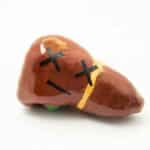- How Drinking Can Lead To Liver Disease
- Symptoms Of Steatosis
- Risks Of Alcohol-Related Liver Disease
- Risk Factors
- Diagnosing Alcohol-Related Liver Disease
- Treatment Options For Fatty Liver Disease
Alcohol-related fatty liver disease is an early stage of liver disease caused by excessive alcohol intake. It is also known as hepatic steatosis and is characterized by the buildup of fatty tissue in the liver.
People who drink around 4 to 5 standard drinks per day, or struggle with chronic heavy drinking, have approximately a 90 percent chance of developing alcoholic steatosis. If left untreated, fatty liver disease can progress into inflammation, liver cirrhosis, liver failure, and death.
In 2019, there were over 85,000 liver disease-related deaths in the United States. Over 40 percent of these deaths were alcohol-related.
How Drinking Alcohol Can Lead To Alcohol-Related Liver Disease
After alcohol enters your body, it is mostly metabolized, or broken down, by enzymes in the liver. Alcohol dehydrogenase, or ADH, is the primary enzyme involved in alcohol metabolism.
Alcohol consumption can affect the breakdown of lipids in the liver. Lipids are fatty compounds that serve various purposes in the body, and do not stay in the liver under normal circumstances.
When alcohol is present in the body, triglycerides and cholesterol that pass through the liver may not be processed properly. Instead they may buildup in the liver and contribute to the buildup of fatty tissue in the liver, or fatty liver disease.
Symptoms Of Alcohol-Related Steatosis
As an early stage of chronic liver disease, alcohol-related steatosis often has few symptoms. While lipids may build up in and around the liver, the liver may still function normally.
Tangible symptoms may include slight abdominal pain and fatigue.
Risks Of Alcohol-Related Liver Disease
If left untreated, steatosis can progress into more severe forms of liver injury. Fat can build up around the portal vein connected to the liver, leading to reduced blood flow over time. This condition is known as portal hypertension, a potentially life-threatening condition.
Steatohepatitis
Alcohol-related steatohepatitis, the next stage of alcohol-related liver disease, is a form of liver inflammation. Patients at this stage may display signs of jaundice, or yellowing of the skin. Portal hypertension may fully develop during liver cirrhosis.
Liver Fibrosis, Cirrhosis, & Cancer
Steatohepatitis can progress into liver fibrosis and liver cirrhosis, where collagen and scar tissue form on the liver, respectively.
The liver may struggle to function properly at these stages, or fail completely. The final and most severe stage of liver damage is hepatocellular carcinoma, or liver cancer.
Risk Factors For Alcohol-Related Liver Disease
Patients who suffer from various conditions may be at a higher risk of alcohol-related liver disease compared to patients in the general population, including:
- type 2 diabetes
- obesity
- metabolic syndrome
- high blood pressure
- alcohol use disorder
Diagnosing Alcohol-Related Liver Disease
Convenient, easily accessible methods for assessing liver health are not common in modern medicine. Instead, patients with a history of heavy alcohol use may be subject to physical exams and screening for alcohol use disorders.
Physical exams may involve blood tests, liver imaging tests, and a liver biopsy.
Patients who meet the criteria for an alcohol use disorder may be recommended for further treatment, and be informed about the risk of alcohol-related liver disease.
Treatment Options For Alcohol-Related Fatty Liver Disease
Between 2010 and 2016, over 33% of liver transplant patients received the procedure because of alcohol-related liver disease.
These rates were higher than other forms of liver damage such as hepatitis C. However, liver transplants may not be accessible to everyone who needs them, and they are not always successful.
Many patients with alcohol-related liver disease also suffer from malnutrition. Dietary supplements can help patients implement lifestyle changes and even remedy alcohol-related health problems. Zinc and Vitamin E supplements have shown promise in reducing symptoms in some studies.
Abstinence from drinking can be effective in reducing symptoms and even reversing early stages of chronic liver disease. People who binge drink regularly may have trouble quitting without professional help.
To learn about our high-quality treatment program for alcohol use disorder, please contact Northeast Addictions Treatment Center today.
Sources
- AASLD Journals — Diagnosis and Treatment of Alcohol-Associated Liver Diseases
- Alcohol Research — Alcoholic Liver Disease: Pathogenesis and Current Management
- National Institute on Alcohol Abuse and Alcoholism — Alcohol Facts and Statistics
- National Library of Medicine: MedlinePlus — Fatty Liver Disease
Written by
Northeast Addition Editorial Team
©2024 Northeast Addition Center | All Rights Reserved
This page does not provide medical advice.





